Scouting--September 1998
A Plan and a Vision
By Jon C. Halter
Photographs by John R. Fulton Jr., Roger Morgan, and Michael Roytek
At the BSA national annual meeting in San Antonio,
Scouters committed themselves to a bold, new strategic plan focusing on
values, leadership, and character
Scouters arriving in San Antonio for the 1998 National Annual Meeting of the Boy
Scouts of America were, like the rest of the nation, baffled and confused by recent
accounts of children, some as young as Cub Scouts, shooting and killing their
classmates and teachers.
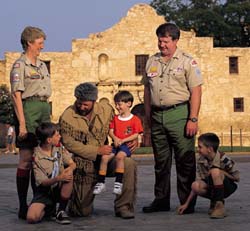
At the legendary Alamo, Sara and Doug Seaborne,
from Indiana's Hoosier Trails Council, and the Scout brothers Grubbs from San Antonio
(Boy Scout Jorden, Tiger Cub Jakob, Webelos Scout Jonah) listen to local Scouter (and
history buff) Steve Baker's insider's view of history. |
Such violence by children with little or no sense of right and wrong was difficult
to explain or comprehend. But to those attending the BSA's 79th annual meeting, the
schoolyard shootings dramatized why, more than ever, America's youth need Scouting's
program of character development and values-based leadership training.
About 2,000 volunteer leaders and their spouses from more than 325 local councils
came to the Alamo City's downtown Marriott hotels to celebrate Scouting's growth
and achievements in the 1990s. They honored outstanding adult volunteer leaders
and youth members, listened to inspiring speakers, shared experiences and improved
personal skills in workshops and seminars, and learned about BSA programs and
support materials.
And they dedicated themselves to a new four-year National Strategic Plan which
focuses on the critical issues that will insure Scouting's even greater growth
and success in the new century.
A great challenge
In his address on the 12th point of the Scout Law--"A Scout is reverent"--at the
Duty to God Breakfast, Dr. Paul Cedar, chairman and chief executive officer of
Mission America, a national coalition of evangelical ministries, focused on one
possible explanation for the recent school shootings.

Dr. Paul Cedar praised Scouting for helping youth
learn reverence. |
"We live in an irreverent age, where most young people have not seen or even heard
about the Ten Commandments," Dr. Cedar pointed out. "They believe values are relative
and violence is an easy way to resolve problems...."
Young people "desperately need someone to help them learn to be reverent," he stated,
and meeting this need is "one of the great challenges of our society."
Reverence means respect for God, which leads to respect for parents, teachers, and
leaders, he said. And while young people usually learn reverence in their own family,
or their church, synagogue, or place of worship, they also "can learn it in the
Scouting movement"--in which the 12 points of the Scout Law "are the basic building
blocks of life and of character."
The BSA is "leading the way" in instilling reverence in youth, Dr. Cedar concluded,
offering his "profound thanks to you for what you are doing for the young people of
America...for teaching young people across this nation and around the world that a
Scout is reverent."
Words of experience and wisdom
A variety of workshops and seminars--from "Positive Public Relations" to "Risk Management"
to "Commissioner Service"--offered Scouters opportunities to learn more about special BSA
programs or areas of activity.
The Cultural Awareness and Marketing session focused on methods for reaching Hispanic-American,
African-American, and Asian-American ethnic groups.
"You must forget everything you thought you ever knew about Scouting" to successfully establish
Scouting units in African-American urban communities, advised Catherine Smith of the Burlington
(N.C.) Housing Authority. "Saying 'That's the way we've always done it' just won't work."
Traditional attitudes about uniforms, for example, need adjusting. In general, Smith noted,
boys will become excited about their Scout uniforms, but they won't wear them to school--or
even on the street.
"They're proud to be Scouts--but they're not crazy," said Smith. "It would be suicide for
Scouts to wear their uniforms outside in some neighborhoods; the colors might conflict
with gang colors."
Young people have a need to belong, to be part of a group, Smith said. "If we don't make
Scouting the group that a young man chooses to belong to, then the gangs will become the
group.
"Urban Scouting is one of the most exciting ventures you've ever done in your life," Smith
concluded. "But you've got to be inspired yourself in order to inspire others."
In a seminar on International Scouting, Dr. Jacques Moreillon, secretary general of the
World Organization of the Scout Movement, said WOSM member national Scout associations may
differ in membership requirements or other areas, but "they all have the same purpose and
method--the moral, physical, and spiritual development of a young person; outdoor activities;
adult leaders; the patrol method."
Better program, training, and marketing
Scouters at the Boy Scout Program Enhancement seminar learned about coming changes in
advancement requirements and improvements to The Boy Scout Handbook and the
Scoutmaster Handbook. Joe Glasscock, national Boy Scout Division director of
program development, announced that new editions of both handbooks are due around Feb.
1, 1999. He also noted that this is "the first time revisions of the two have been
released at the same time."
At the Passport to High Adventure workshop, Bruce Walcutt, chairman of the BSA camping
task force, reported that "This summer 40,000 campers will participate in national and
local council high adventure programs--the highest number ever."
Because reservations for summer treks at Philmont Scout Ranch fill so quickly, Dave Bates
recommended units try high adventure programs offered by at least 55 local councils. Bates,
who is director of camping and conservation, Boy Scout Division, said the Daniel Boone
Council in Asheville, N.C., is scheduled to host 4,200 campers this summer. He said another
program, run by the Daniel Webster Council, offers sea-kayaking, mountain-biking, and
backpacking at its Mead Wilderness Base in New Hampshire.
The Training 2000 workshop focused on increasing training opportunities for Cub Scout
leaders. "Why training?" asked presenter Burt Corsen, training coordinator for California's
Santa Clara County Council, then answered his own question: "Quality program!"
Corsen and Scouters from other councils ranking high in percentage of leaders with Cub Scout
Leader Basic Training shared their proven methods, including close tracking of the training
record of every leader, delivering training in a variety of ways, and encouraging Scouters
to take advantage of Cub Scout Trainer Wood Badge courses and the summer conferences at the
Philmont Training Center.
Scouters in the Marketing the Cub Scouting Program workshop learned how the success of the
Indianapolis-based Crossroads of America Council's School Night program, featuring the cartoon
character Garfield, has ignited plans for a National Garfield Roundup Program, planned for fall
1999. Other councils also shared tips for School Nights and various marketing efforts to
increase membership and unit growth.
"Be creative," urged moderator Jon Graska of the National Cub Scout Committee. "Tailor
roundups and marketing to your communities, districts, and councils. And you need a good
relationship with schools."
An answer for the future
The annual business meeting gave BSA officials an opportunity to review the past and
focus on the future.
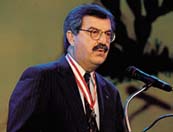
Creighton was impressed by volunteers'
enthusiasm. |
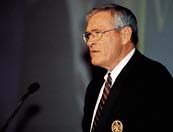
Growth must continue, said new President
Whitacre. |
Outgoing BSA President John W. Creighton Jr. reported that 1997 was "a terrific year"
which reflected "the Scouting family's commitment to achievement." Membership increased
"in every program and every age-group we serve," to a total of more than 4,573,600 young
people (a four percent gain over 1996).
"Because of their enthusiasm for Scouting," Creighton concluded, "I sincerely believe
that our volunteers and professional Scouting family can accomplish any task that they
set out to do."
The immediate task at hand-the BSA's Strategic Plan 1998-2002-was introduced by incoming
BSA President Edward E. Whitacre Jr. The plan features five critical issues and strategies
for special attention as Scouting enters the 21st century: Leadership, Total Financial
Development, Traditional Unit and Membership Growth, Marketing, and Endowment Emphasis
and Stewardship.
"The key to the future of the Boy Scouts of America is continued growth in our traditional
programs," Whitacre noted. "We need to add more than 2,000 traditional units every year
and 90,000 members a year just to maintain our market share."
New recruiting initiatives in all programs, however, will help surpass that rate, he added,
and bring BSA youth membership to a projected total of more than 5 million in 2001.
"I challenge you to take this new national plan and build your local council plan around
it," Whitacre said. "As we enter a new century, help us make Scouting bigger and better
than ever for the youth of America."
Chief Scout Executive Jere B. Ratcliffe offered a response to those who despair at ever
finding an answer to the current crisis of youth.
"Scouting has an answer," he declared. "These fine [volunteer leaders who] every week
provide the role models do make a difference, do provide an answer to young people who
are looking for guidance."
The new National Strategic Plan provides "a vision for the future," Ratcliffe said.
In achieving its goals, "the Boy Scouts of America will continue to be the premier youth
service organization in America."
Jon Halter is editor of Scouting magazine. Executive Editor Scott Daniels and
Associate Editor Kathy Vilim DaGroomes also contributed to this article.
Whitacre Is New BSA President
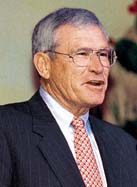
The BSA national meeting's closing banquet featured a tribute to outgoing President
John W. Creighton Jr. and the installation of incoming President Edward E. Whitacre
Jr. "I feel good about what is taking place in Scouting in America today," said
Creighton in summarizing his many visits to units, districts, and councils and with
countless professional and volunteer Scouters. "No matter where I visited there was
an enthusiasm for Scouting and a compassion to serve young people that cannot be
equaled anywhere else in society today."
New BSA President Whitacre has been a member of the BSA National Executive Board since
1992, serving most recently as executive vice president. He has also served as president
of the St. Louis Area Council, as a member of the Southern Region Executive Board, and
currently is on the Alamo Area Council Executive Board.
"It's a great honor for me to take on the responsibilities of national president,"
Whitacre told the banquet audience. "...Back when I was earning my merit badges as part
of Troop 210 in Ennis, Tex., I never thought I'd be a troop leader, let alone president
[of the BSA]."
Whitacre is chairman and chief executive officer of San Antonio-based SBC Communications
Inc., one of the world's leading diversified telecommunications companies.
His many civic affiliations include serving as a member of the board of regents of Texas
Tech University and Texas Tech University Health Sciences Center. |
Up, Up, and Away With An Eagle Scout
Scouters at the national meeting's Americanism Breakfast heard Distinguished Eagle
Scout Award recipient and businessman/adventurer/explorer J. Stephen Fossett describe
how his sense of adventure was nourished at age 11 on his Boy Scout troop's monthly
camp-outs.
Later came such exploits as sailing solo across the Pacific Ocean and competing in
Alaska's Iditarod Trail Sled Dog Race, the 24 Hours of Le Mans sports car race, and
the Ironman Triathlon.
His latest goal is to become the first person to circumnavigate the globe solo in
a balloon.
To date, his ballooning exploits include the first solo flight across the Pacific
Ocean, in 1995, and a world distance record of 10,361 miles, from St. Louis to
Sultanpur, India, in January 1997.
Although his first three around-the-world attempts had failed, Fossett remained
determined to succeed on his next try, scheduled for August 1998 at the time of his
talk. His goal, he said, is simply to "earn a place in aviation history" by circling
the globe in "the only form of aviation that has not accomplished the feat."
Unlike the crafts of several rival balloonists who are also trying to accomplish the
famous first, Fossett's balloon, "Solo Spirit," carries no corporate advertising.
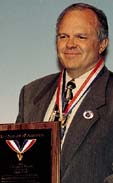
"I am a spokesman for what I believe in," he declared, "and this flight stands for
romance, personal achievement, and adventure." On his next attempt, his craft would
carry three images: the United States flag, the Explorers Club flag, and the emblem
of World Scouting.
Fossett, a member of the National Advisory Council of the Boy Scouts of America, is
chairman of Lakota Trading Inc. and president of Marathon Securities Inc.
"Most of us want some adventure in our lives," he told his BSA breakfast audience.
"You, too, can do adventures-but I urge you to make them ones you are truly
interested in." |
Highlights and Accomplishments
Other national meeting highlights included these 1997 accomplishments:
- The Eagle Scout Award was earned by 40,296 Scouts, the second-highest number
ever and a one percent increase over 1996.
- The National Court of Honor awarded Honor Medals With Crossed Palms to five
Scouts or Scouters for heroism, extraordinary skill, or resourcefulness "in
saving or attempting to save life at extreme risk to themselves." Another 258
Scouts and Scouters received other awards for lifesaving and meritorious action.
- More than 38 percent of Cub Scouts (nearly 570,000 boys) participated in a day,
resident, or family camping experience. Boy Scouts going on a long-term camping
expedition reached the highest level ever, with more than 57 percent of all Boy
Scouts and Varsity Scouts participating.
|
Top of page
Return to Scouting table of contents
Copyright © 1998 by the Boy Scouts of America. All rights thereunder
reserved; anything appearing in Scouting magazine or on its Web site may
not be reprinted either wholly or in part without written permission.
Because of freedom given authors, opinions may not reflect official
concurrence.





